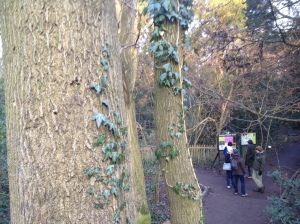“If you really want to know your trees in winter, you have to get physical with them. In an appropriate way of course.”
Daniel Greenwood, a conservation officer for the London Wildlife Trust, smiled wryly as he gestured a gnarled trunk behind him.
It was an early gambit on a winter tree identification walk last Sunday, a bright, frosty afternoon in Sydenham Hill Wood.
Chuckles came from our cluster of fellow walkers standing on this large preserved stretch of the Great North Wood, one of the closest tracts of ancient woodland to central London.
“Run your hand across their bark,” he went on. “Even hug them if you want.”

Clasping a battered Collins tree guide, Daniel cut a boyish figure, his auburn hair peeking from beneath a woollen hat. He would prove that rare find: a mine of information who is able to share knowledge in an entertaining, often amusing, way.
“Don’t believe everything I tell you, by the way” he warned while explaining the difference between sessile and English oaks, how hybrids had formed and were difficult to tell apart. “Tour guides lie all the time.”
Mendacious or not, he built a fine picture of the woodlands and its evolution as we wandered along its frost-lined paths.
At one stop, he pointed through the trees at an out-of-place canopy to demonstrate how this was once part of an ornamental garden.
“That’s the monkey puzzle, also known as the Chilean pine. Which country do you think it comes from?”
Somebody answered that time. By the time we reached a later stop, and heard the same query of a towering cedar of Lebanon, everyone had tuned into our tour leader’s dry humour.
Shortly he would be trying to teach everyone a dance as a mnemonic for the way trees grow – with limited participation, admittedly – but we remembered.
Dance moves and all, the walk lasted a little more than 90 minutes as we trooped around the reserve with a wide-ranging history lesson en route. We gained a sense of the pivotal role woodland has played in shaping the history of London and beyond. Before the days of coal, furnaces would have burned less brightly without charcoal from the hornbeam. Horatio Nelson’s navy would have been less formidable without oak timbers to form his ships, and the city’s leather makers less profitable without the trees’ tannin.
Daniel was prolific with the flora facts. Ancient woodland was not actually that good a place to see ancient trees, we learned – the really old ones mostly occupy their own isolated spaces. Dead wood is a much richer habitat than living trees, mostly for insects – including the stag beetle here; and birches are a great woodland pioneer as they can take root in open ground.
Smatterings of history of the non-arboreal kind – and even a hint of linguistics – also cropped up. Just off one path was a crater created by an unexploded World War Two bomb. And who knew the etymology of “the bottom has fallen out of the market” or in it “for the long haul” [lugging wood along extended stretches] are both from the timber trade?
There was a snippet of economics (London trees reportedly being worth around £43 billion to the economy), as we overlooked Dulwich golf course with dozens of ring-necked parakeets squawking above us. (“What do we think of them?” asked one walker. “Well, there’s a bird walk on February 12).”
Here too were more sobering tales, of soil too compact to be fertile, and of encroaching tree disease – not just the well known ash dieback, but acute oak decline, a condition not yet as widely recognised, Daniel told us.

“We really need to wait for them to develop natural resistance in about 10,000 years. Let’s see what happens then.”
Our loop came towards its end once as we filed along the overgrown abandoned railway line that dissects the reserve. The tracks fell into disrepair after Crystal Palace, a terminus, had burned down in 1936. Now it is largely reclaimed by nature and leads into a disused tunnel, a protected roosting spot for bats.
Daniel gave a final bit of background on Sydenham Hill Wood and how it had helped shaped the London Wildlife Trust, then bade us farewell. “I hope you’ve learned at least one thing today,” he said. “And I think the dance is going to catch on.”
As we climbed back up to street level, we all felt a little more love for this wonderful pocket of wild London and its trees. In an appropriate way, of course.
- This was a free guided walk put on by the London Wildlife Trust. Find out more London Wildlife Trust events.
- Find out more about the history of Sydenham Hill Wood.
